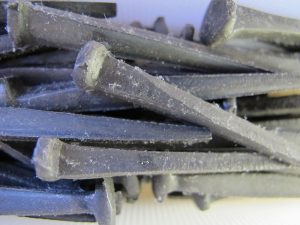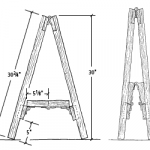We may receive a commission when you use our affiliate links. However, this does not impact our recommendations.
I use cut nails in my furniture projects. They hold better and look better than common wire nails. They do have a couple downsides, however. They are more expensive than wire nails and more difficult to find. You cannot walk down to the local hardware store and buy a bag.
Well, let me qualify that last sentence a bit. You actually can purchase cut nails at the hardware store, but they are super-hard nails designed for masonry, not furniture. In a pinch, I’ve used these masonry nails for carcase construction, but I am not a fan. Many of them have too smooth a finish, which reduces their holding power. And some masonry nails have too much taper, which means they will split the wood, even if you drill a pilot hole for the nail.
So if you want cut nails, your best bet is to get some that are made by Tremont, which are sold directly from the manufacturer and other resellers, such as Tools for Working Wood, which packages them in nifty bags.
I’ve tried to get some information on La Belle cut nails from its West Virginia factory, but haven’t received a reply. Another good source for cut nails is eBay; old boxes of nails show up all the time. Shipping for these bargains, however, can be a killer.
But the biggest questions for most woodworkers are: What types of nails should I buy? And what sizes? Here are the nails that I stock in my shop and what they are good for.
Carcase Construction
For nailing together carcases and installing drawer runners, I prefer the “fine finish standard” nail because I like the way it looks. Some people prefer the look of the “box nail” or the “brad standard.” All of them work.
To select the correct sizes of nails you need to consider the thickness of wood you are nailing through. The rule of thumb is that you first convert the thickness of the top board into eighths – so a 1/2”-thick board is four-eighths; a 3/4” board is six-eighths. The numerator is the size of nail you should use for that board – a 4d nail and a 6d nail in these examples.
For carcase work, I use 3d nails (1-1/4” long) for toenailing and installing drawer runners, 4d nails (1-1/2” long) for nailing into rabbeted case work and 6d nails (2”-long) for full-on nailing through 3/4” material.
Trimwork
The best nails for installing moulding are the “fine cut headless brads.” They are crazy expensive, but worth it. After paying for a few boxes you’ll realize why early cabinetmakers took the time to straighten any bent nails. I keep 2d brads (1”-long) on hand for small mouldings, plus 3d and 4d brads for larger mouldings.
Cabinet Backs
I prefer nails with a good-sized head to hold my cabinet backs in place. Sometimes I’ll use a “clout” nail for this, but I prefer the look of the “wrought head” nail that comes with a black oxide finish. As to sizes, I use 4d wrought heads for 1/2”-thick backs and 6d nails for 3/4” backs.
There are other specialty nails for hinges and clinching, but I don’t keep these on hand. I buy them only when I have an upcoming project that requires them.
I keep all my nails in a plastic tackle box, which is perhaps the ugliest thing in my workshop and is something I intend to fix this year by building a traditional nail cabinet. These wall-hanging cabinets look like a lot of work because they have lots of drawers, but they are easy to build – thanks to nails.
— Christopher Schwarz
Here are some supplies and tools we find essential in our everyday work around the shop. We may receive a commission from sales referred by our links; however, we have carefully selected these products for their usefulness and quality.















I just last week received 2 boxes of cut nails from Tremont. I bought a nice bradawl on eBay…waiting for it to cross the pond. Saw you and Roy talking about how the bradawl can help a cut nail not split your wood.
I like the way these nails work in softer or green woods, in hard woods or dryer woods there is a certain finesse needed
Hi Chris
I’m using the cut nails subject matter to wedge in a question about your recommendation of using cut nails in Woodworking Magazine #6 (Simple Seachest) to nail into end grain as a way of fastening side to front.
I have been taught that it is bad form to fasten into endgrain with nails or screws. Also it’s not worth the effort to glue endgrain. One should try to use dowels (blind, Miller,or otherwise).
Do you care to comment?
Also check your local flea market or antique mall. I walked out with a zip-lock bag full of cut nails in a variety of sizes. They were slightly rusted but functional, which is fine by me as I tend to make reproduction furniture and the rust is desired by the clients. This is also the source for most of my hand tools.
you can also check with your local blacksmith. (Yes, these still exist.) They can often custom make nails, which most should chuckle about until they realize you are serious.
There are a couple of places to look to find them, as most of them have advanced beyond mere coal for smithing, but I’d suggest checking out SOFA (Southern Ohio Forge and Anvil) for a list. You can also check out your local phone book for Blacksmiths. (They may also be under “metal shops” or “machine shops.”)
http://www.leevalley.com
They carry four sizes of cut nails, all nicely finished and really nice quality. Price is reasonable as well (in my assessment). If you have a store close to you they’re a great source, otherwise their eStore is fine as well.
Another source for cut nails is Lehman’s:
http://www.lehmans.com/store/Tools_Farm___Old_Fashioned_Steel_Cut_Nails?Args=&customField1=W9
No matter what, one never has the right nails (or screws for that matter) for the job at hand. Oh sure, they are there somewhere, but where!
http://www.theintelligencer.net/page/content.detail/id/547549/LaBelle-Nail-Closes-After-158-Years.html?nav=515
This says LA BELLE closed in 2010.
As always, thanks for passing along some valuable information. I just received mu first order of nails from Tools for Working Wood. Good source to get smaller quantities to try out different nail sizes or styles.
Do you have some simple guidance for the size and depth of the pilot hole that should be drilled?
Thanks for the great information, I have been looking for these type of nails, they just seem to add a touch of class to my work.
Thank you for this article, Chris. Looking into cut nails for future projects has been on the to-do list. Great stuff!
When your driving long cut nails and the heads twist to one side ,just use the claw end of your hammer to twist it back.
What about the Square-cut Nails that Lee Valley have for sale? are they good?
Very good article that is informative on a topic that only woodworkers and possibly somebody applying for Jeopardy will care about. I like cut nails and have a decent amount of very old ones I take from my company’s warehouse, which is a 150 year old building with 3+ inch thick floor joists.
I won’t go as far as to call you Poindexter, though. I liked the “numerator” you threw in to the article. It’s a 10 cent word.
I was amazed just how good these nails are.
Like a lot of woodwork practices, the old methods usually are better!
For those of you who are interested, have a look at this website (www.glasgowsteelnail.com). It’s the last company making cut nails here in the UK, but it has a lot of information and history.
Thanks for the article.
I’m about to build my first hand tool project – a 5 board bench out of SYP (Instead of the 6 board chest, I decided to go for the “easy win” … I hope). I’ve got some 8d and 6d fine finish. I can’t wait to try it out!
Thanks for the articles. I love reading your work.
Numerator? Hold on there, Poindexter.
Good entry. I once sat in front of the entire display of nails down in Wareham trying to figure out which nails were best suited for different projects.